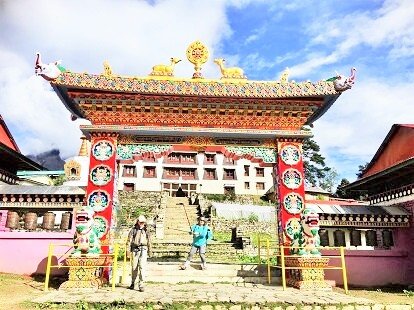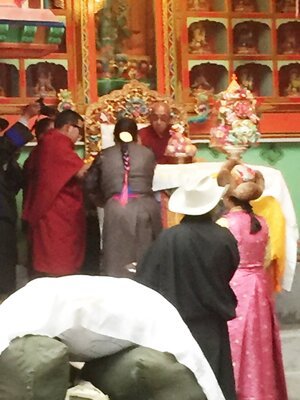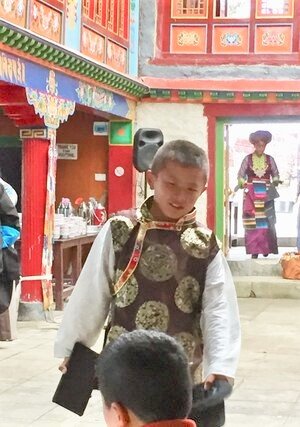vaga #7/7 Tibetan Buddhist world
part VII
Tibetan Buddhism is appreciated at its best by being in its own land. This national park "Sagarmatha" that borders Tibet. Formerly there were no borders, it was only an ethnic culture that was divided in two with China's invasion of Tibet in 1958. There are many Tibetans in this area, others went to different parts of Nepal and India mainly. That is why I dedicate this chapter to "Tibetan Buddhism" and what I saw in my walk, its expressions and manifestations that have been going on for more than 5 thousand years. Yes, I like mountains, but as I said before, now a magic is added, a spiritual energy that of Tibetan Buddhism. It touched me strongly, it impacted me because it was also my first experience in the Himalayas. Later I did two trekkings, one to the center of the country in Langtang Park, with Peter, and the other to the West in the Annapurna Range, and you don’t feel the same energy.
From the Lukla exit you can see in abundance the prayer flags, not very large temples, a couple of monasteries that Gopal indicated when passing, many stone icons, sacred drums, stupas. You walk on the sides, underneath, you get imbued as you pass, they involve you. By the fourth day of ascending the symbols are already noticeably distant because there are no inhabitants. I have already narrated a lot of this but the intention of this blog is to put them all together and even so I hardly repeat photos because there are many icons and to give the feeling of abundance, of insistence on symbols, the magic in every corner. You have to add all the images since they overlap each other
In the previous chapter I described "The Doors" that had to be crossed. Now I add "The Drums" of prayer. They are of all sizes, outdoors or under a niche, in others you have to cross between two for your blessing. Calculation to say something in those first 4 days is about 40. At some point we came across about 7 of these drums lined up and the curious thing was that water passed underneath, it was a stream and made each one turn unstoppably
"The Stones" carved like this, I also mentioned them in the previous chapter, however I repeat some because they are the sum of so many religious images. The stones with carvings of mantras, written in the "Pali" language of ancient Buddhism with which the teachings and wisdoms are transmitted, known as "dharma", others only with symbols. In the rows of flagstones or any icon and you must walk up the left and go down the right side. Not all trekkers respect it.
“The Stupas” also mentioned above are everywhere, always white, of different sizes, some very sophisticated and well maintained, while most were in a state of disrepair. Back to the eyes about 30 stupas, some strategically located at high points and in valley folds so that they can be seen from all sides.
"The Sacred Flags" also previously reported in "Vaga # 1 Puff Nepal". "Flags" of Tibetan prayers where I explained their symbols, their colours and how they are located in valleys so that the wind carries prayers of hope, compassion and how they are present in such remote places, on bridges for gratitude and protection, in valleys, houses ...
Tengboche Monastery
The famous and beautiful monastery located at 3,800 metres high is the largest in the Khumbu region. Built in 1923, then destroyed by an earthquake in 1934 and with a carpenter from Lhasa, Capital of Tibet, they rebuilt it with beautiful architecture and very fine carpentry work in wood carvings, then a fire in 89 it was destroyed again. Later rebuilt with the help of people from all over the world respecting the architecture that stands out for its beauty. The murals painted by artist Kappa Kalden, very colourful and very well preserved to this day, are a piece of art. They live like 10 monks. In addition to beauty, it is geographically located in a narrow valley between the snow-capped mountains surrounding it by great peaks such as Everest, Nuptse, Lhotse, Ama Dablan. Sherpa Tenzing Norgay, the first man to reach the top of Everest with Edmund Hillary, born in this area, and he was a monk in this monastery
The drawing in the centre in the interior ceiling of the access portal is the mandala of Nirvana.
In the photo below it is a hillside in a valley that can be reached after 5 days, a closed valley, that is, with no exit or walking trail. It is a sacred valley and belongs to the Tibetan Buddhist world. For several weeks the entire valley is closed and all the inhabitants have to go to other nearby valleys including their animals. This happens once a year when about 5 or 7 monks go to meditate in some caves located on that slope. The caves in the photo would be in the very centre of the photo, they cannot be seen from afar. I slept in the nearby tea house in a hamlet of about twenty houses right there where I took this photo. The trekking route also adapts to changes when the monks are meditating with pure water.
Rafael, entering a world out of this world
It was only worth traveling from Kathmandu to see what we had to see and return, totally justified the trip. By chance, we had already lost a day in Kathmandu due to not being able to fly due to bad weather and we would not have got to see this Buddhist holiday in Namche Bazaar, the day of rest for acclimatisation. Gopal, it was reported right there that there was a Buddhist festival in the town, he asked us if we would be interested in going, there was no need for me to answer this, it was a wonderful coincidence. At around 10:30 am he took us to the community house that was already preparing for the festivity and he left us alone. Next to us he told us the monks were beginning the prayers and if we wanted to attend we could go. Of course, and there is the photo of Rafael entering the monastery attached to the community house of the town.
A woman of about 40 years old approached us when she saw us enter and silently signalled us towards a space immediately to the left, everything was very small. A small room of about 6 meters by 25 meters and saturated with decorations. She showed us where to sit, a bench against the wall. We were both speechless about seeing where we were. About 8 monks on one side praying mantras and omg aloud to the beat of moving back and forth. They served us tea, over and over again to keep warm. It was cold and there was only a small brazier. Always the same woman, she was the one who coordinated everything, she filled the tea cups every so often for the monks and us, welcome, it was cold and she fanned the fire. Then after a while 2 faithful arrived and sat next to us, we deduced that they were authorities, Plop and us. As it was a festival, the meditation was not the usual one and not even the daily ones were very produced. What an impression, I asked the woman with signs for permission to take photos and she said yes. Everything was taken with maximum discretion, Rafa didn't even shy away from taking out the phone and I was going to share it with him and I with my guts in hand I did it without moving from my seat and without distracting anyone. The photos do not speak, nor the videos, since the intensity of the environment, and especially the intimacy of the moment in which we were involved, cannot be captured and narrated, I am left short. It was the intimacy that overwhelmed me the most, the closeness of the bodies, the instruments next to one, the incense, the fire, the cold. Silently thanking each refill of the tea, what we were witnessing and grateful that Rafael was with me because he would never imagine an experience like this, I have had extreme experiences, but alone and this was with him. It was another world, one straight out of a book of fables.
For two hours sitting on the 25-centimetre-wide bench, we no longer had a way to accommodate ourselves, but it mattered little to us. The environment saturated with very colourful silk fabrics and arranged in certain ways, the music consisted of two long tubes, or horns like those of the Swiss Alps with which they communicate between valleys in the mountain, here very, curiously the same , a vertical drum and cymbals, cornets, castanets, an unknown music, and incense and strange hats that at some point were put on. At the head of the eight young monks there were 3 more senior monks and one gave the guidelines of the rites, or rang the bell or cornets. I felt intrusive, even uncomfortable, totally out of place, but I couldn't help being mesmerised, fascinated, and frozen in time. Never felt a bad face from them with us, I remember that in several mosques, whether they are simple and large and more beautiful, they would not let me enter because I was not a Muslim and here it was the opposite, even more so to be involved in the rite. At the hour the superior monk arrived, a man of about 90 years old who sat on a platform and recited a sermon for a long time, a rest, and the music started and then he resumed the speech, that lasted more than an hour, monotonous, ( the one with the drum fell asleep, and the paparazzi with the photo, the last one) but between the lapses different things happened. The festival was regional. We managed to understand the woman so that we could return later to the community house. Which we did.
We returned to the big house after a while, there was activity of people arriving and I suppose the monks had finished their rites. The house has a large central double height space. The second floor with the gallery-type windows surrounded the interior space. The place was very beautiful, over-decorated with colourful geometric and floral paintings on every inch of doors, frames, beams and in excellent care. In the centre were about 15 sacks of rice, a donation for the monastery.
They placed us on a bench behind the wall, and we were very quiet, waiting for the ceremony to begin. A woman touched us and told us to follow her…. Hmmm? She took us to the second floor by gesturing. In one corner there was a large stove with a fire. It was the kitchen with a lot of activity. They made us cross the kitchen between several boiling pots and busy women into a 5 x 3 metre room, the dining room. A table with U-shaped stools and men eating. There were be about 15 older men with their white hats, and they showed us where to sit. I gulped and my stomach tightened. We sat tightly packed, they didn't look at us, I felt uncomfortable, I didn't even know why I was there. As soon as we sat down they gave us several plates of food, rice, vegetables, noodles, soups, the rest was unrecognisable and tea. Rafa didn't believe it and neither did I, He told me in a low and hushed voice- how do they invite me here if I look like a gringo, tall, blond, with blue eyes- I asked myself the same thing, sometimes those crazy things happen to me for being alone, an older woman and I never expected something like that so extreme to share with Rafael. The first time Rafa asked me to take a picture of him, because he himself didn't believe it. Sitting, it was very narrow there was no space for photos, nor wanting to be disrespectful, so no photographic value but a unique experience to the paparazzi. Rafa swallowed everything with pleasure and encouragement, I was always more demure and hesitant and he ended up eating everything including mine, saved !!! There I could see the diners who were arriving because they were taking turns since there was no space for everyone at the same time they gave way to each other, and there was one using that space and eating from their food when entering the dining room there was a small table, a woman sitting with a book. Each guest who arrived gave a donation, a tea bag, several kilos of rice, oil, eggs etc…. and she was writing down the name of the person and their contribution in the book. I quietly mentioned it to Rafa and what we should do. The logical thing was to leave some rupees, and what would be the appropriate amount? We calculated blindly, two lunches plus a contribution for the generosity, he took out the hidden money and separated it. We finished lunch and soon left the space to others and I subtly offered the money to the lady at the table, but she did not accept it, (the last photos a woman and a man looking for the donation in his pocket and the woman with the book)… .. Once again impressed. Stunned.
We got up after about 25 minutes and the place was taken over, I would say around 400 people, they came from the surroundings. On one side only the older women sit, on the right side of them the horn musicians are located and on the other side along the space is the platform where the 90-year-old superior monk sits, the one who was in the monastery in In the morning, next to the drum and cymbal musicians, the older men sit beyond and behind them and the monks close to the wall. Facing the older women there are chairs for men in their 30s and 40s and there is access to the lounge. Facing the stage throughout the hall are those who come to special ceremonies where the monk will give them a blessing. I understood marriage commitments among others and behind them the public and relatives, young women, children and us. Rafa tells me that he realised that a whole generation was missing, and yes, there were hardly any young boys, we supposed that they are working as carriers far from the town.
A commotion began at the entrance, and the superior monk in ceremonial garb entered. This monk does not live in the monastery of the town and he came especially to do the blessings of the town, not only those of the town and all the blessings are made for the year. Rafa heard that they brought him by helicopter, surely it is impossible for him to walk. He wore a large hat and sat in the chair at the height of a dais and began a monotonous sermon, long, about 40 minutes, without a change of affectation with his voice. It started to get boring, Rafa elbowed me to see a young monk standing next to the old man, it was the monk who looked after the superior, he spoke in his ear, surely to finish the sermon, he did it over and over again, already people were tired, distracted and wanted the festivity to begin now. As it is, finished, finally the music started and the music was played by the monks
It began with the entrance of costumed dancers who danced around the room. They were three witches who scared off evil spirits, with images of skulls, we learned that they were the same monks in disguise. One watched without understanding anything and there was no one to ask, I think that not even google would know.
About ten young people in their traditional clothes walked in a line with their rice sacks on their shoulders and passed in front of the superior monk and he gave them a white silk scarf of thanks.
There were marriage commitment ceremonies, others of older couples who made complicated curtsies in search of blessing, older women alone who also approached the monk to talk to him and to give him an offering, the "Montblanc" chocolate being large as the most appreciated jewel. There were many different celebrations, unintelligible rites, we were the only ones from outside and without Gopal or anyone to explain to us, we just stared in amazement, I recorded a lot for the music.
A rite that is often done every 20 minutes or something like that and all in unison including the public throwing rice into the air and praying by putting some grains in the palms of their hands and moving their fingers in very curious, complicated and novel ways. like the boy who was sitting next to me, paparazzi photo
4 hours after this we left for home even without it having finished and more than what the morning added in the monastery we were emotionally exhausted, visually, and from living those many hours in another place outside the known planet. No narration or video would manage to depict that experience fully.




































































































































